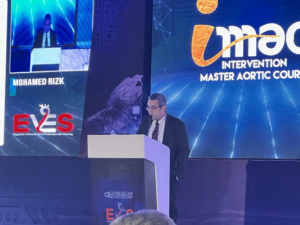
During a presentation at the Egyptian Vascular and Endovascular Society (EVES) 2024 Summit (30 October–2 November, Cairo, Egypt) on managing abdominal aortic aneurysm (AAA), Mohamed Rizk (Ain Shams University, Cairo, Egypt) extolled the benefits of acquiring both open and endovascular skills to ensure the best outcomes for patients.
Rizk first considered the guidelines on this topic. He detailed that the UK National Institute for Health and Care Excellence (NICE) suggests using open repair—unless contraindicated—for uncomplicated, unruptured AAA, while the European Society for Vascular Surgery (ESVS) supports the use of endovascular aneurysm repair (EVAR) for these patients.
Regarding elective repair for complex or juxtarenal aneurysms, the presenter noted that NICE favours open repair. The ESVS, on the other hand, states that both open and endovascular techniques have equal benefit in these cases. These guidelines recommend fenestrated EVAR specifically for an endovascular approach.
Against this background, Rizk went on to share the results of a retrospective comparative study from his centre on the use of open surgery versus EVAR for the management of AAA. The study included 61 patients.
The presenter detailed that he and colleagues retrospectively reviewed their data from 2014 through 2020, dividing patients into two groups: those treated with open surgical repair and those treated with EVAR.
There were few statistically significant differences in the demographics between the two groups, Rizk highlighted, with notable exceptions being a higher average age and a smaller average aneurysm size in the EVAR group.
Sharing the results of the study, Rizk noted that intraoperative mortality was 4.6% in the open group compared to 0% in the EVAR group and that the combined rate of in-hospital and 30-day mortality was 4.9% in the open group compared to 0% in the EVAR group.
The presenter continued that operative time and length of hospital stay were both shorter in the EVAR group than in the open surgery group.
Alongside the headline results of the retrospective study, Rizk also shared details of some specific cases that were included.
First, the presenter recalled the case of a 73-year-old male who was a non-smoker and had good exercise tolerance with an ejection fraction of 62%. The patient’s computed tomography (CT) scan showed an abdominal aorta with no neck and an aneurysm of 10cm in diameter.
The plan was to treat this patient endovascularly, Rizk shared. However, while this was a “very appealing” option, the presenter added the caveat that it would have been expensive and “exposed the patient to the hazards of spinal cord ischaemia and contrast-induced neuropathy”. In the end, the team performed open surgery, resulting in an “uneventful” postoperative period that has lasted out to three years thus far.
Another case involved a 50-year-old male who presented to the emergency room with severe abdominal pain. He had a pulse of 120 and a blood pressure reading of 84/40. Rizk recounted that resuscitation was performed, followed by a CT angiography. A bedside echocardiogram revealed a 47% ejection fraction, and the patient was diagnosed with a leaking thoracoabdominal aneurysm.
“The best plan for this patient was an endovascular option,” Rizk said. However, he recalled that the team required a branched device, which was not available on label. As a result, the team performed open surgery, with the presenter reporting a positive outcome for the patient.
In a third case, a 60-year-old male with a gap of 3.5cm in front of his mesenteric vessels underwent endovascular repair due to this complex anatomy. Rizk reported that this approach brought about a good result that has been maintained at one-year follow-up.
Rizk summarised that EVAR is associated with improved 30-day morbidity and mortality over open surgery and might be the best option for elderly patients with small aneurysms and favourable neck anatomy. Younger patients and those with more complex anatomy, on the other hand, might benefit more from an open approach.
Alongside this summary, Rizk pointed out that the specific comorbidities and anatomy of each patient must be considered when managing AAA, as exemplified by the case examples he shared. The presenter also stressed that “sticking to the IFU [instructions for use] gives the best results for EVAR patients”.
“Tailor the intervention according to the patient,” Rizk stated as one of his take-home messages. He encouraged delegates to consider all the on-the-shelf tools they have available and urged them to “master all techniques” for the management of AAA. “You never know when you might need them.”













